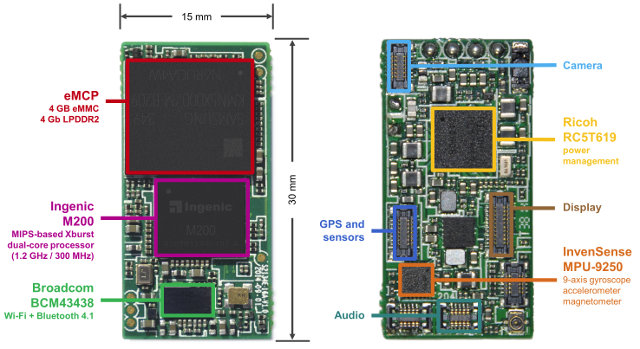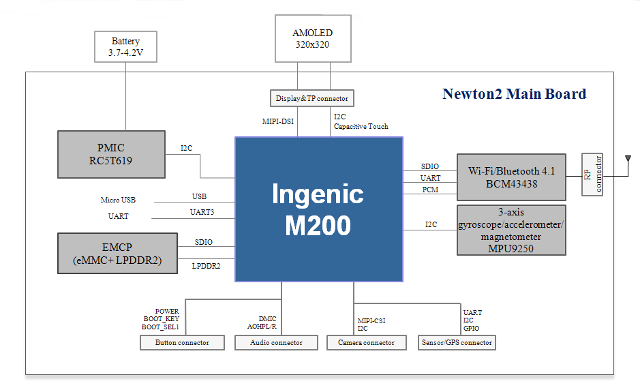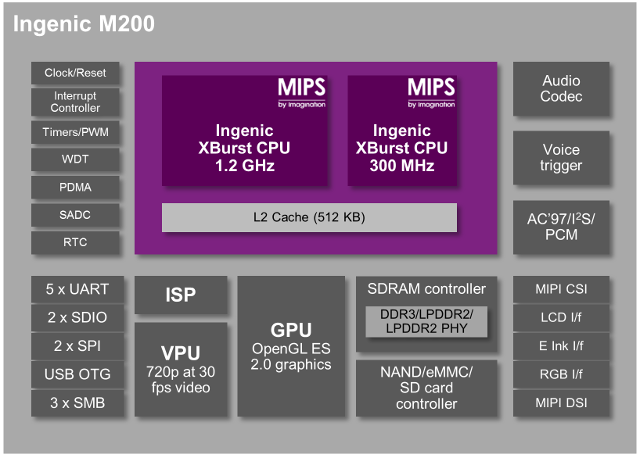Ingenic Newton is a development platform for wearables powered by Ingenic JZ4775, an application processor mostly used in tablets. Many companies are now making SoCs speficially designed for wearables with a powerful application core, and a low power core serving as a sensor hub, an Ingenic M200 SoC found in the new Ingenic Newton2 platform, uses the sample principle by combinging a MIPS XBurst processor @ 1.2GHz with a low power MIPS XBurst core @ 300MHz combined with low power GPU and VPU.

Ingenic Newton2 specifications:
- SoC – Ingenic M200 dual core processor with MIPS XBurst @ 1.2 GHz, MIPS XBurst @ 300 MHz, 2D/3D GPU, and VPU supporting H.264, VP8, MPEG-1/2/4, VC-1, and RV9 up to 720p30
- System Memory – 512 MB LPPDR2 (Samsung eMCP)
- Storage – 4GB eMMC (Samsung eMCP)
- Connectivity – 802.11 b/g/n Wi-Fi + Bluetooth 4.1 (Broadcom BCM43438) + connector for GPS
- Sensors – Gyroscope, accelerometer, magnetometer (IvenSense MPU-9250)
- Expansion Headers – 24-pin display connector, MIPI CSI / I2C camera connector, DMIC and AOHPL/R audio connector, GPS and sensors header including UART, I2C, and GPIO pins. touch connector, 14-pin button connector, and 4-pin Wi-Fi and 2.4 GHz BT connector.
- Power Supply – Li-on battery: 3.7~4.2V or Micro USB: 5.0V; Ricoh RC5T619 PMIC; Standby power consumption: < 3 mW
- Dimensions – 15 x 30 x 2.4 mm

Compared to the original Newton board, Newton2 is about 50% smllaer, and consumes much less power resulting in improved battery life. Target applications include smartwatches, augmented reality headsets, smart glasses, smart cameras, wearable healthcare monitors, activity trackers, smart clothing, etc… The platform runs Android 4.4 + Linux 3.10, but there’s no mention of Android Wear support.

| Package | BGA270, 7.7mm x 8.9mm x 0.76mm, 0.4mm pitch |
| CPU | XBurst1-HP core, 1.2 GHz XBurst1-LP core, 300 MHz |
| GPU | 2D/3D acceleration with OpenGL ES 2.0/1.1. OpenVG 1.1 |
| VPU | Video encoder up to 720p @ 30fps: H.264, VP8 Video decoder up to 720p @ 30fps: H.264, VP8, MPEG-1/2/4, VC-1, RV9 |
| ISP | HDR, video and image stabilization, crop and rescale, auto exposure + gain + white balance + focus control, edge sharpening, noise reduction, color correction, contrast enhancement, gamma correction |
| Memory | DDR2, DDR3, LPDDR, LPDDR2 up to 667 Mbps 64-bit ECC NAND flash support Toggle 1.0 and ONFI2.0 |
| Display | LCD controller with OSD: TFT, SLCD and MIPI-DSI (2-lanes) E-Ink controller |
| Camera | MIPI-CSI2 (2-lanes), DVP |
| Audio | Audio CODEC with 24-bit ADC/DAC, stereo line-in, MIC in, and headphone interface Low power DMIC controller AC97/I2S/SPDIF interface for external audio codec One PCM interface, supports both master and slave modes Voice trigger engine to wake system by programmable specific voice |
| ADC | 3 channels 12-bit SAR |
| Interfaces | USB 2.0 OTG x 1 MMC/SD/SDIO controller x 2 Full-duplex UART port x 5 Synchronous serial interface x 2 Two-wire SMB serial interface x 4 |
| Software | Android 4.4 |
Ingenic M200, or another Ingenic SoC for wearables (M150), is said to be used in GEAK Watch 2, which can deliver 2-week of battery life. The crowdfunding campaign for the watch is still on-going.
Pricing and availability have not been disclosed for Ingenic Newton2, and if history is any guide, the board will be reserved to corporate customers, just like Ingenic Newton was. More details may be found on Ingenic Newton2 ad M200 SoC product page.

Jean-Luc started CNX Software in 2010 as a part-time endeavor, before quitting his job as a software engineering manager, and starting to write daily news, and reviews full time later in 2011.
Support CNX Software! Donate via cryptocurrencies, become a Patron on Patreon, or purchase goods on Amazon or Aliexpress




